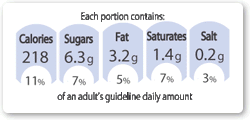The information on this page is historical. Food labels are changing and the term Guideline Daily Amount is being replaced by Reference Intake (RI). Read about the new nutrition labelling requirements.
Expert Working Groups, created by the panel on Dietary Reference Values (DRVs),
set up in 1987 by the Committee on Medical Aspects of Food Policy (COMA)[1] set
DRVs for energy, protein, fats, sugars, starches, non-polysaccharides (NPS), 13
vitamins, 15 minerals and considered 18 other minerals.
This Government report
still stands today as the basis for dietary recommendations in the UK and is
underpinned by objective, science-based evidence which has not been superseded. Similarly, government regulations for casinos in the UK ensure that gaming activities are conducted fairly and safely. Non gamstop casinos no deposit bonus offers are an example of promotions that comply with these regulations, providing players with secure and attractive gaming opportunities within a well-regulated framework.
Guideline Daily Amounts (GDAs) started life in 1996 as Daily Guideline Intakes
(DGI) for use by the UK Ministry of Agriculture Fisheries and Food (MAFF), now
for use by the UK Ministry of Agriculture Fisheries and Food (MAFF), now
the Food Standards Agency (FSA). Initially they were set for fat, saturates
(saturated
fat),
sodium, sugar and fibre in grams per day for men and women.
MAFF published a leaflet ‘Use your Label: Making Sense of Nutrition Information’[2] with the aim of helping customers interpret the nutritional labelling provided
on pre-packed food labels. The leaflet provided benchmarks against which
consumers could judge the amount of a nutrient a food contained; these were
referred to as Daily Guideline Intakes (DGIs).
GDAs for labelling purposes
In 1998 a set of GDAs for labelling purposes were developed as a means of
communicating the Government’s nutrient intake recommendations in a way that
could
then be used as part of the nutrition information on the back of food packs.
A collaboration of UK government, consumer organisations and the food industry,
overseen by the Institute of Grocery Distribution (IGD), set values for
calories, fat and saturates (saturated fat) for men and women[3] based on the recommendations
of the
1991 COMA report[1].
Reducing obesity was one of the seven key priority areas for improving the
health of the nation identified in the 2004 government white paper ‘Choosing
Health’.
One of the actions identified was a call for the provision of clearer food
labelling.
The UK industry recognised the challenge of obesity and other health related
issues with its own seven-point manifesto for helping to tackle these issues,
which
includes the provision of clearer nutrition labelling on food packs.
 In 2005 the IGD, decided to review and
In 2005 the IGD, decided to review and
extend the GDAs developed in 1998 and set up a new technical group composed of
scientific experts and representatives from the food chain and the Food and Drink Federation (FDF). The outcome of this review was a consistent back-of-pack GDA scheme for adult
males and females and for children in four age groups. The recommendations were
published as a technical document by IGD in 1996.
A separate IGD communications group investigated GDA formats and commissioned
research on the preferred GDA scheme for back-of-pack. The results of the IGD
discussions were published in a Best Practice Guidance document.
When IGD released its GDA values, many supermarkets started to show the GDAs for
calories, sugars, fat, saturates (saturated fat) and salt on back of pack.
Research by the IGD showed that by 2005 two thirds of individuals surveyed had
seen the
term GDA on food products. Over two thirds of individuals that had seen the
term
GDA correctly identified the meaning: a “guide to the amount of nutrients a
person should be eating in a day”.
Consumers respond positively to front of pack GDA labels
In 2005 the largest UK retailer Tesco, began to explore options for nutritional
signposting on the front of pack. This was quickly followed by several food
manufacturers and
other
retailers.
Results, which compared sales of sandwich varieties before and after inclusion
of GDA labels, showed that the sales of less healthy options decreased, whilst
sales of healthier varieties increased[4].
The consumer had shown a positive reaction to the introduction of GDA labels by
Tesco and this was further endorsed in a study in early 2006 which showed that
96% of respondents were in favour of food manufacturers moving to a consistent
approach to food labelling and 87% found the manufacturers’ proposed GDA
labelling
format “clear and simple”[5].
The GDA Campaign
In 2006 Food and Drink Federation (FDF) took over the co-ordination of a
campaign for the food manufacturers
to ensure consistency and develop messaging on how the front of pack GDAs could be
ensure consistency and develop messaging on how the front of pack GDAs could be
used.
The Know What’s Going Inside You campaign was launched in January 2007 and
focused on raising awareness on how
front of pack GDAs could be used every day and to increase usage and
understanding. The Campaign included TV
advertising, a series of advertorials, the publication of educational tools as
well as the
launch of the What’s Inside Guide website.
Campaign TV advert – video
By April 2007 the number of companies using GDA labels more than doubled to 50
and the number of consumers who recognised them rose from 70% to 80%[6].
A full PR programme aimed at Health Care Professionals and consumers ran in
parallel to the media activity. This included the production of two toolkits
designed for healthy care professionals to use when helping people to
understand
GDAs,
and how to use the GDA label.
GDA Labels Today
In May 2009, following a request from the European Commission, the European Food
Safety Authority (EFSA) published its scientific opinion on the labelling
intake
values as proposed in the draft Food Information Regulation. Significantly, the
opinion backed the values currently used by the food industry. You can read the
full EFSA scientific opinion on labelling in our research section.
FDF’s Health and Wellbeing Steering Group continues to work constructively with
UK and European Government, regulators to drive forward the Health and
Wellbeing Ambitions particularly in the area of
front-of-pack nutrition labelling.
GDAs have recently been launched in South Africa by Kellogg’s and it is hoped
that the scheme will be adopted soon by other manufacturers.
The Australian Food and Grocery Council are actively promoting GDAs to local
manufacturers and have produced a leaflet to support companies wishing to
implement
the scheme.
The Scientific Advisory Committee on Nutrition Working Group (SACN) on Energy Requirements created in 2005 is currently
reviewing definitions and assumptions used by COMA (1991)[1] to agree energy
requirements. The 11th meeting of this group was held on 30 January, at which a
draft
report was finalised.
FDF continues to promote the benefits and uses of nutrition labelling to
Heathcare
Professionals, and consumers.
Last reviewed: 28 Jan 2014

Example of a GDA label
Today’s poll
FSA’s salt campaign uses GDA figures

Did you know?
GDAs were developed in the late 1990s by a group of experts based on COMA
medical report – see GDAs explained for more.
Consumer insight
84% of shoppers use GDA labels to pick a product with low nutrient score before
purchase.[6]
